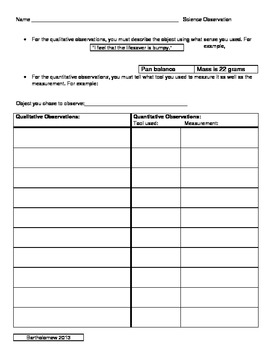Science - Quantitative and Qualitative Observation Worksheet
Amy Bartholomew
97 Followers
Grade Levels
2nd - 12th, Higher Education, Adult Education, Homeschool, Staff
Subjects
Resource Type
Standards
CCSS2.MD.A.1
CCSS2.MD.A.2
CCSS2.MD.A.4
CCSS3.MD.A.2
CCSS4.MD.A.1
Formats Included
- Word Document File
Pages
1 page
Amy Bartholomew
97 Followers
Description
This worksheet is designed to help students differentiate between qualitative and quantitative observations. There is a place to record the qualitative observations that students make using the five senses as well as a place to record the quantitative observations using more formal data. Students are also asked to record what tool was used to gather the quantitative data. This is a great activity for students first learning about scientific inquiry and practicing how to make observations and gather data. You can use this with a variety of measurement tools such as a thermometer, measuring cups, pan balance, graduated cylinder, spring scale, metric ruler, etc. which makes it fun and hands-on learning!
This can also help tie your Science lesson into your Common Core Mathematics standards as students are working with units of measurement.
This is a great back to school science lesson to do with students!
I welcome feedback and let me know if you need me to make any changes to the document!
Quantitative and Qualitative Observation Worksheet by Amy Bartholomew is licensed under a Creative Commons Attribution-NonCommercial 3.0 Unported License.
This can also help tie your Science lesson into your Common Core Mathematics standards as students are working with units of measurement.
This is a great back to school science lesson to do with students!
I welcome feedback and let me know if you need me to make any changes to the document!
Quantitative and Qualitative Observation Worksheet by Amy Bartholomew is licensed under a Creative Commons Attribution-NonCommercial 3.0 Unported License.
Total Pages
1 page
Answer Key
N/A
Teaching Duration
N/A
Report this resource to TPT
Reported resources will be reviewed by our team. Report this resource to let us know if this resource violates TPT’s content guidelines.
Standards
to see state-specific standards (only available in the US).
CCSS2.MD.A.1
Measure the length of an object by selecting and using appropriate tools such as rulers, yardsticks, meter sticks, and measuring tapes.
CCSS2.MD.A.2
Measure the length of an object twice, using length units of different lengths for the two measurements; describe how the two measurements relate to the size of the unit chosen.
CCSS2.MD.A.4
Measure to determine how much longer one object is than another, expressing the length difference in terms of a standard length unit.
CCSS3.MD.A.2
Measure and estimate liquid volumes and masses of objects using standard units of grams (g), kilograms (kg), and liters (l). Add, subtract, multiply, or divide to solve one-step word problems involving masses or volumes that are given in the same units, e.g., by using drawings (such as a beaker with a measurement scale) to represent the problem.
CCSS4.MD.A.1
Know relative sizes of measurement units within one system of units including km, m, cm; kg, g; lb, oz.; l, ml; hr, min, sec. Within a single system of measurement, express measurements in a larger unit in terms of a smaller unit. Record measurement equivalents in a two-column table. For example, know that 1 ft is 12 times as long as 1 in. Express the length of a 4 ft snake as 48 in. Generate a conversion table for feet and inches listing the number pairs (1, 12), (2, 24), (3, 36),...


